

Truth or lie? Can MRI help scientists read our minds? By Dr Donna Rose Addis, Centre for Brain Research, University of Auckland It’s the slogan of a new game show on TV3, but can science help us tell the two apart?

Mind Reading has always been thought of as a superhuman skill, but fMRI technology is bringing us ever closer to this goal. So-called ‘functional Magnetic Resonance Imaging’ tracks blood oxygen levels across the brain, allowing scientists to visualise what brain regions ‘light up’ during different types of cognition. Of course this is an indirect measure, as we assume that the more oxygen a brain area consumes, the more it is doing — as thinking is hungry work! The (supposed) myth of the 8-hour sleep. Last week a sleep colleague and I gave a presentation to a group of GPs.
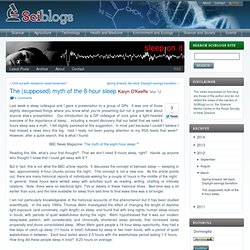
It was one of those slightly disorganised things where you know what you’re presenting but not a great deal about anyone else’s presentation. Our introduction by a GP colleague of ours gave a light-hearted overview of the importance of sleep… including a recent discovery that our belief that we need 8 hours sleep was a myth. I felt slightly panicked at this suggestion. In most part because I couldn’t believe I had missed a news story this big. Sciblogs Events. Whizz for anti-atoms! Talking to people who have seen or read "Angels and Demons" by Dan Brown, which features CERN quite heavily, they expect to be disabused.
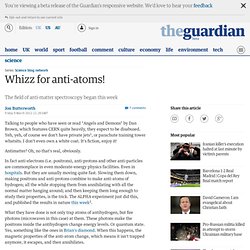
Yeh, yeh, of course we don't have private jets1, or parachute training tower whatsits. I don't even own a white coat. It's fiction, enjoy it! Antimatter? Oh, no that's real, obviously. In fact anti-electrons (i.e. positrons), anti-protons and other anti-particles are commonplace in even moderate-energy physics facilities. What they have done is not only trap atoms of antihydrogen, but fire photons (microwaves in this case) at them. The frequency to which the microwave has to be tuned in order to cause this gives a measure of the difference between the different energy levels inside the anti-hydrogen. This is the first time we've measured inside anti-atoms.
The current measurements aren't very precise, but they are the first. There's nothing like an actual measurement. 1 tell me about it, I'm in the Geneva departure lounge yet again. LED's efficiency exceeds 100% (PhysOrg.com) -- For the first time, researchers have demonstrated that an LED can emit more optical power than the electrical power it consumes.
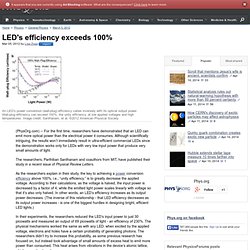
Although scientifically intriguing, the results won’t immediately result in ultra-efficient commercial LEDs since the demonstration works only for LEDs with very low input power that produce very small amounts of light. The researchers, Parthiban Santhanam and coauthors from MIT, have published their study in a recent issue of Physical Review Letters. As the researchers explain in their study, the key to achieving a power conversion efficiency above 100%, i.e., “unity efficiency,” is to greatly decrease the applied voltage. According to their calculations, as the voltage is halved, the input power is decreased by a factor of 4, while the emitted light power scales linearly with voltage so that it’s also only halved.
In other words, an LED’s efficiency increases as its output power decreases. More information: Parthiban Santhanam, et al. Tevatron experiments see possible signs of the Higgs boson in favored region. Experiments at the Tevatron collider have seen possible hints of the Higgs boson.
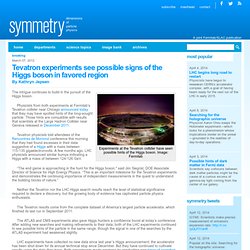
Image: Fermilab The intrigue continues to build in the pursuit of the Higgs boson. Physicists from both experiments at Fermilab’s Tevatron collider near Chicago announced today that they may have spotted hints of the long-sought particle. Those hints are compatible with results that scientists at the Large Hadron Collider near Geneva released in December 2011. Tevatron physicists told attendees of the Rencontres de Moriond conference this morning that they had found excesses in their data suggestive of a Higgs with a mass between 115-135 gigaelectronvolts. “The end game is approaching in the hunt for the Higgs boson," said Jim Siegrist, DOE Associate Director of Science for High Energy Physics.
The First-Ever Images of Atoms Moving Inside a Molecule. Strong solar storm heading for Earth. The QWERTY Effect: How Typing May Shape the Meaning of Words. UPDATE: The results of the QWERTY study described in this story were questioned by independent researchers, and the study authors have responded to the criticisms.
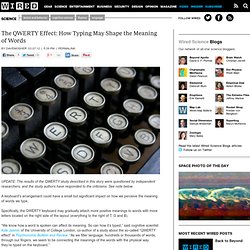
See note below. A keyboard’s arrangement could have a small but significant impact on how we perceive the meaning of words we type. Specifically, the QWERTY keyboard may gradually attach more positive meanings to words with more letters located on the right side of the layout (everything to the right of T, G and B). “We know how a word is spoken can affect its meaning. So can how it’s typed,” said cognitive scientist Kyle Jasmin of the University of College London, co-author of a study about the so-called “QWERTY effect” in Psychonomic Bulletin and Review.